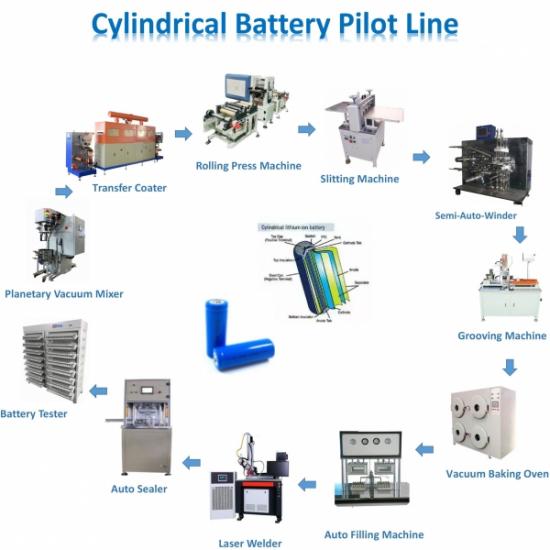Lith Corporation, founded in 1998 by a group of material science doctor from Tsinghua University, has now become the leading manufacturer of battery lab&production equipment. Lith Corporation have production factories in shenzhen and xiamen of China.This allows for the possibility of providing high quality and low-cost precision machines for lab&production equipment,including: roller press, film coater,mixer, high-temperature furnace, glove box,and complete set of equipment for research of rechargeable battery materials. Simple to operate, low cost and commitment to our customers is our priority.
What is a Car Battery Assembly Line?
A Car Battery Assembly Line refers to the systematic and automated process used to assemble battery modules and packs for use in modern electric vehicles (EVs), hybrid electric vehicles (HEVs), and plugin hybrids (PHEVs). While traditional leadacid batteries also have their own assembly lines, this explanation focuses on lithiumion battery assembly lines, which are central to the EV revolution.
The assembly line typically integrates premanufactured battery cells into modules, and then combines those modules into a complete battery pack that powers the vehicle. This stage follows the cell production phase, where individual cells are fabricated from raw materials.
Key Objectives of a Car Battery Assembly Line
1. Efficient Integration of Battery Cells into Modules and Packs
Assemble thousands of battery cells per hour into standardized modules
Combine modules into a fully functional battery pack with all necessary components
2. Ensure High Quality and Consistent Performance
Maintain tight tolerances in electrical connections and mechanical fit
Perform realtime diagnostics and testing during assembly
3. Support Scalability and Flexibility
Adapt to different battery chemistries, formats, and vehicle platforms
Enable rapid reconfiguration for new product designs
4. Maximize Automation and Minimize Manual Labor
Use robotics, conveyors, and smart systems to reduce human error
Improve throughput and reduce cycle times
5. Integrate Digital Manufacturing Tools
Implement MES (Manufacturing Execution Systems) for full traceability
Use IoT sensors and AIbased monitoring for predictive maintenance
6. Promote Safety and Sustainability
Ensure safe handling of highvoltage components
Incorporate fire suppression, gas detection, and clean energy practices
Stages of a Car Battery Assembly Line
A typical car battery assembly line consists of three main stages:
1. Cell Inspection and Sorting
Before integration, battery cells undergo final quality checks to ensure they meet performance specifications.
# Activities:
Incoming cell inspection:
Visual and dimensional checks
Voltage, internal resistance, and capacity testing
Sorting by performance metrics:
Grouping similarperforming cells together to ensure balanced module performance
Traceability tagging:
Each cell is labeled with a unique ID for future tracking
This step ensures only qualified cells proceed to the next stage.
2. Module Assembly
Battery cells are assembled into modules, which are modular building blocks of the final battery pack.
# Substages:
Cell stacking or placement:
Cells are positioned in a defined arrangement inside the module housing
Busbar installation:
Conductive metal strips connect cells in series or parallel configurations
Thermal interface material (TIM) application:
Heatconductive pads or glue applied between cells and cooling plates
Module housing assembly:
Structural casing is closed around the cells with brackets and fasteners
Internal wiring and sensor installation:
Temperature sensors and voltage taps connected to the Module Management Unit (MMU)
Functional testing:
Communication signals, voltage balance, and thermal conductivity verified
Labeling and storage:
Modules are stored in climatecontrolled environments before pack assembly
Modules can vary in size and complexity depending on the vehicle platform.
3. Pack Assembly
In this final stage, multiple modules are integrated into a complete battery pack, along with additional components required for operation in the vehicle.
# Substages:
Module loading:
Modules are placed into the pack housing (typically aluminum or steel)
Cooling system integration:
Liquid cooling plates or air channels installed for thermal management
Battery Management System (BMS) installation:
Central control unit mounted and wired to each module
Highvoltage harness installation:
Main power cables and connectors added for vehicle interface
Structural bonding and sealing:
Pack sealed to IP67 or higher protection rating against dust and water
Final functional testing:
Full pack tested for insulation resistance, communication with ECU, and highvoltage integrity
Leak testing and safety validation:
Ensures no moisture ingress under pressure changes
Pack labeling and shipping preparation:
Final quality check, serial number marking, and packaging for delivery
Once completed, the battery pack is ready for integration into the vehicle production line.
Cylindrical cell production line
Supporting Infrastructure in a Car Battery Assembly Line
To ensure efficient, safe, and sustainable operations, several support systems must be integrated alongside the physical assembly processes.
1. Clean Room & Climate Control
Dustfree zones for sensitive electronics and connectors
Controlled temperature and humidity to avoid condensation or degradation
2. Fire Safety & Explosion Protection
Gas detection systems for flammable electrolytes or solvents
Fire suppression systems using clean agents or water mist
Emergency ventilation and isolation protocols
3. Automation & Robotics
Robotic arms for precise busbar welding and module handling
Conveyor systems for seamless material flow
Laser welding and vision systems for highquality connections
4. Digital Manufacturing & Traceability
MES (Manufacturing Execution System): Tracks every component from start to finish
IoT sensors: Monitor pressure, temperature, and alignment
QR/RFID tags: Enable full lifecycle traceability of each battery pack
5. Waste Management & Recycling
Collection and disposal of defective parts and excess materials
Reuse of packaging materials and energyefficient lighting
Integration with battery recycling programs for endoflife modules
Types of Car Battery Assembly Lines
Depending on ownership, scale, and technology focus, these lines can be categorized as:
1. OEMOwned Assembly Lines
Operated directly by automotive manufacturers
Example: Tesla, BMW, Toyota, Ford
2. Battery Supplier Assembly Lines
Run by specialized battery companies supplying to OEMs
Example: CATL, LG Energy Solution, Panasonic
3. Joint Venture Assembly Lines
Shared ownership between automakers and suppliers
Example: VW + Umicore, Stellantis + Samsung SDI
4. Startup or Niche Technology Lines
Focused on advanced technologies like solidstate batteries
Example: QuantumScape, Factorial, Blue Solutions
Key Considerations When Designing a Car Battery Assembly Line
When planning your battery assembly line, consider the following factors:
| Area | Consideration |
|||
| Location | Proximity to cell suppliers, logistics hubs, and skilled labor |
| Battery Chemistry | NMC, LFP, solidstate, etc. |
| Cell Format | Cylindrical, pouch, or prismatic |
| Annual Capacity | Target output (e.g., 1–10 GWh/year) |
| Automation Level | Manual, semiauto, or fully automated |
| Factory Layout | Workflow, clean room placement, scalability |
| Environmental Compliance | Fire safety, emissions, waste treatment |
| Workforce Development | Training engineers, technicians, and operators |
| Partnerships | Suppliers, OEMs, research institutions |
Benefits of a Car Battery Assembly Line
Enables largescale EV production with consistent battery supply
Reduces dependency on external suppliers and lowers cost risks
Improves product quality and customization for specific vehicle models
Strengthens local or national battery supply chains
Supports job creation and economic development
Accelerates the transition to electric mobility
Encourages sustainable and circular battery ecosystems
Leading Companies Involved in Car Battery Assembly Line Development
Here are some of the key players involved in designing and operating car battery assembly lines globally:
Battery Manufacturers:
CATL (China) – World’s largest battery producer
LG Energy Solution (South Korea) – EV battery gigafactories
Samsung SDI (South Korea) – Highenergydensity cells
BYD (China) – LFP and blade battery technology
Panasonic (Japan) – Partner of Tesla, cylindrical cell specialist
Automotive OEMs:
Tesla (USA) – Gigafactories for NMC and LFP cells
Volkswagen Group (Germany) – Cellforce Group for solidstate batteries
Ford Motor Company (USA) – Joint venture with SK On
BMW Group (Germany) – Strategic battery partnerships and internal R&D
Toyota (Japan) – Solidstate battery development and plant construction
Equipment and Automation Providers:
KUKA (Germany) – Robotics and automation
Siemens (Germany) – MES and digital twin platforms
Trumpf, Coherent, IPG Photonics – Laser welding and cutting
Hanson Robotics, Gree EnergyTech – Integrated battery line solutions
B&R Automation (ABB subsidiary) – Smart manufacturing systems
Engineering and EPC Firms:
Bechtel, Hatch, Black & Veatch – Turnkey plant construction
Wood, Jacobs, GHD – Engineering and sustainability consulting
Need Help Designing or Optimizing Your Car Battery Assembly Line?
If you're looking to build, expand, or optimize your car battery assembly line, I can help you with:
Master planning – Site selection, process flow, zoning
Process engineering – Battery chemistry, format, and assembly stages
Factory layout design – Clean room integration, workflow optimization
Equipment sourcing – Bestinclass machinery and automation
Sustainability strategy – Green energy, recyclability, circular economy
Cost estimation and ROI analysis – CapEx, OpEx, breakeven modeling
Compliance and safety systems – Fire protection, permits, worker safety
All you need to do is provide the following information:
Battery chemistry and cell format (e.g., NMC, LFP, solidstate, pouch)
Target annual production capacity (e.g., 1–10 GWh/year)
Plant location and available infrastructure
Level of automation and digitalization desired
Current team expertise and strategic goals




 Online service
Online service
